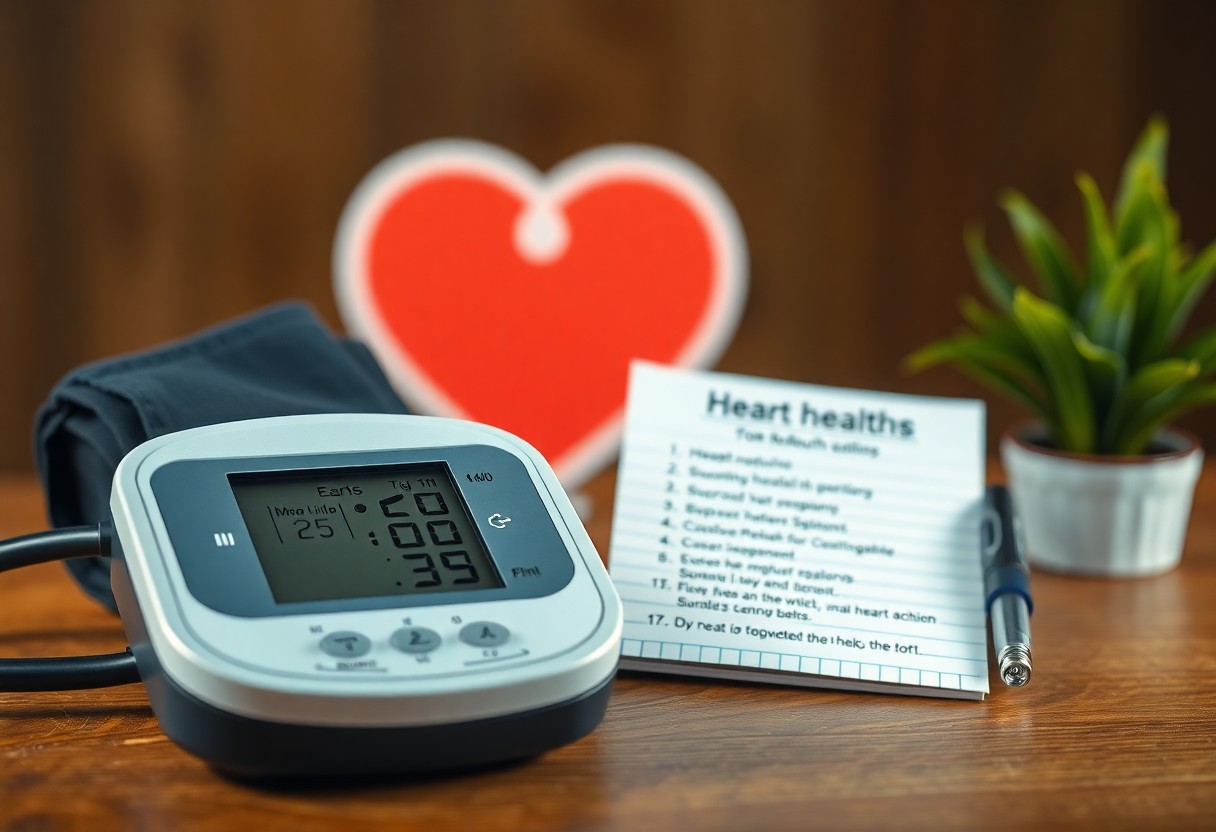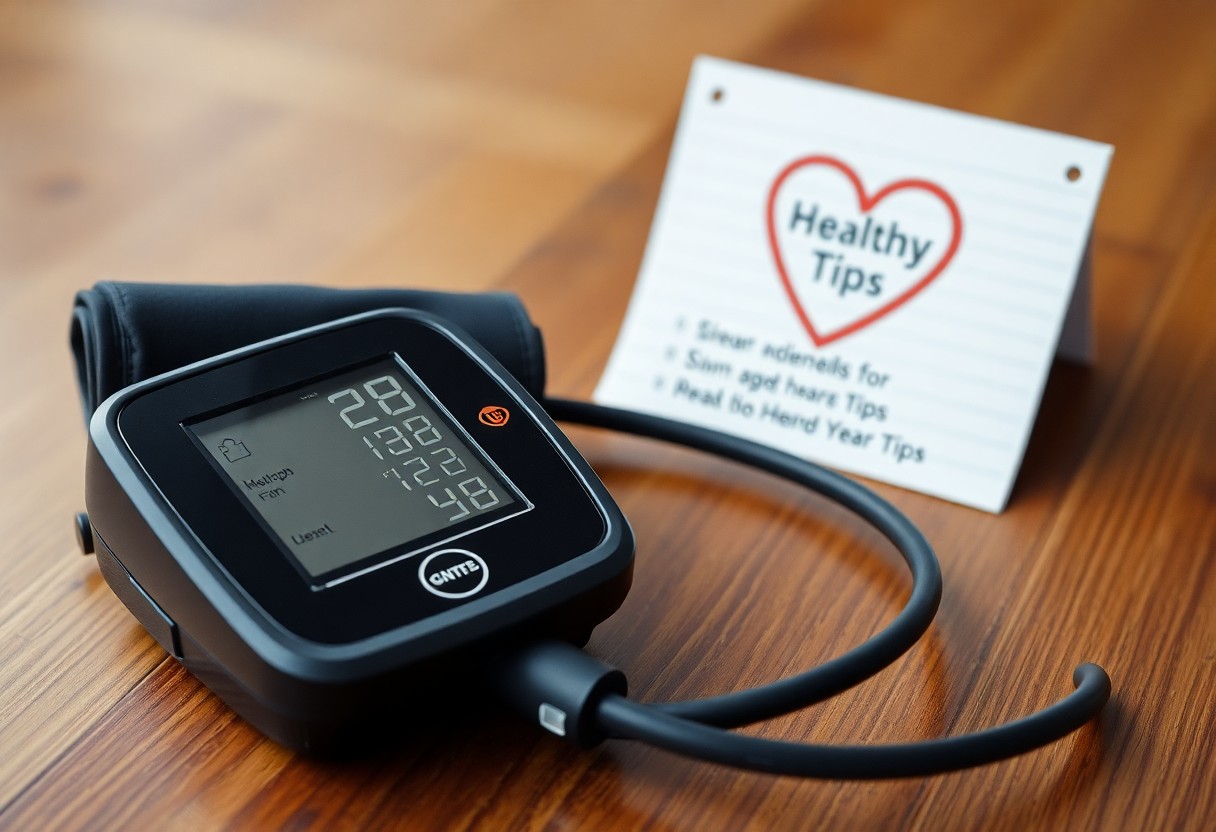Over time, monitoring your blood pressure is vital for maintaining your heart health. High blood pressure, often called the “silent killer,” can lead to serious complications, including heart disease and stroke. Understanding the normal ranges and factors affecting your blood pressure can empower you to take charge of your health. Regular check-ups, a balanced diet, and physical activity can positively impact your numbers. In this blog post, you’ll learn how to effectively manage your blood pressure and keep your heart healthy.

Key Takeaways:
- Understanding blood pressure readings is imperative for assessing heart health; know the difference between systolic and diastolic pressure.
- Maintaining a healthy lifestyle, including a balanced diet and regular exercise, can significantly influence blood pressure levels.
- Regular monitoring of blood pressure can help detect changes early, allowing for timely interventions and better health outcomes.
The Unseen Dangers of High Blood Pressure
High blood pressure, or hypertension, is often dubbed the “silent killer” because it frequently develops with no noticeable symptoms. This can lead many to overlook its presence, placing them at risk for serious health complications. Recognizing that hypertension can damage your arteries, heart, and other organs over time makes it vital to monitor your blood pressure regularly and understand the potential consequences of neglecting this silent threat.
The Silent Killer: Why It’s Called “Hypertension”
Hypertension earns its nickname as the “silent killer” due to the lack of obvious warning signs. Most individuals are unaware they have high blood pressure until a routine checkup reveals an alarming reading. Over time, unchecked hypertension can lead to severe health issues, including stroke, heart attack, and kidney disease, all while you feel fine. This stealthy nature emphasizes the necessity of routine checks and proactive care.
The Link Between Blood Pressure and Cardiovascular Disease
The connection between high blood pressure and cardiovascular disease is well established, with approximately 47% of adults in the U.S. diagnosed with hypertension, many unaware of their condition. Over time, elevated blood pressure can lead to weakened arteries and increased strain on the heart, resulting in conditions like heart failure or coronary artery disease. Prioritizing regular blood pressure monitoring can be a game-changer in reducing your risk.
When blood pressure remains consistently high, it causes your heart to work harder and can lead to structural changes within the heart itself, including thickening of the heart muscle. This change increases the susceptibility to life-threatening events such as heart attacks or arrhythmias. Also, high blood pressure can accelerate plaque buildup in your arteries, contributing to arteriosclerosis or narrowing and hardening of the arteries. Early detection and management of your blood pressure are crucial steps you can take to help mitigate these risks and protect your heart health.
Decoding Your Blood Pressure Numbers
Blood pressure readings consist of two numbers that measure the force of blood against your artery walls. The systolic pressure is the first number, indicating the pressure in your arteries when your heart beats. The diastolic pressure is the second number, reflecting the pressure when your heart is resting between beats. Understanding these numbers is crucial for evaluating your overall heart health and determining your risk for various heart conditions.
Systolic vs. Diastolic: What Do They Mean?
Systolic pressure is a critical indicator of heart health, often reflecting the potential for heart disease. A lower systolic pressure signifies a lower risk, while elevated levels can indicate hypertension. Conversely, diastolic pressure can also provide insights into your cardiovascular system during resting periods. A balance between these two readings is vital for maintaining optimal health, and significant deviations may warrant further investigation.
The Ideal Blood Pressure Range: Knowing the Baselines
Ideal blood pressure typically ranges from 90/60 mmHg to 120/80 mmHg. Readings in this bracket indicate that your cardiovascular system is functioning well, reducing the risk of heart disease, stroke, and other complications. Blood pressure readings above this range can indicate elevated risk, which can lead to serious health issues if left unchecked.
Staying informed about your baseline blood pressure is key to maintaining health. Regular check-ups allow you to track changes over time, helping you to recognize any patterns that may emerge. If your systolic measures exceed 120 mmHg or diastolic exceeds 80 mmHg, you may fall into categories of elevated blood pressure or hypertension, which necessitate lifestyle adjustments or medical intervention. Health professionals recommend aiming for a consistent reading within the ideal range to support long-term heart health and overall well-being.
Lifestyle Choices that Impact Blood Pressure
Your daily habits significantly influence your blood pressure levels. Factors such as what you eat, how active you are, and even stress management play a role. Making intentional lifestyle changes can lead to considerable improvements in your heart health. Focusing on nutrition, exercise, and stress reduction strategies will pave the way for healthier blood pressure readings and enhance your overall well-being.
The Power of Nutrition: Foods that Lower Blood Pressure
Exercise and Activity: Movement as Medicine
Essential Monitoring Techniques for Everyone
Maintaining your heart health involves regular monitoring of your blood pressure. This simple yet effective practice can be pivotal in identifying potential issues. By understanding the necessary techniques for monitoring your blood pressure, you can take proactive steps towards your well-being, ensuring that your numbers stay within a healthy range. Regular tracking will empower you to engage in informed discussions with your healthcare provider.
Blood Pressure Monitors: Choosing the Right One
Choosing the right blood pressure monitor is vital for accurate readings. Opt for an automatic, cuff-style monitor, which is generally more reliable than wrist or finger devices. Make sure the cuff fits properly, as an ill-fitting cuff can skew results. Look for models validated by health organizations, and consider features like memory storage and Bluetooth connectivity for easy tracking of your measurements.
Home vs. Clinic: Where to Measure Blood Pressure
Measuring your blood pressure at home can provide a more accurate picture of your normal levels, free from the stress often associated with clinic visits. Home readings can reveal patterns affected by daily activities, while clinic readings may fluctuate due to “white coat syndrome.” Aim to establish a consistent routine for home monitoring, taking readings at the same time each day for better analysis.
Home monitoring allows you to measure your blood pressure in a comfortable and relaxed environment, which can lead to results that reflect your typical daily levels. Studies show that home readings can often reveal hypertension missed during sporadic clinic visits. You can track your results over time, making it easier to discuss trends with your healthcare provider and adjust lifestyle changes accordingly. Recording your readings consistently helps build a comprehensive understanding of your heart health, no matter where you are or what time it is.
Debunking Common Myths about Blood Pressure
Several misconceptions surround blood pressure that can hinder your understanding and management of it. Among these is the belief that only those who experience symptoms, such as headaches or dizziness, should be concerned about their blood pressure. In reality, hypertension can be a silent condition, meaning one could be at risk without exhibiting any noticeable signs. Another myth is that dietary changes and exercise alone can effectively lower blood pressure without the need for medication, which isn’t always the case for everyone. Understanding these myths allows for more informed health decisions.
“I don’t feel it, so I’m fine”: The Perils of Ignoring Symptoms
Ignoring symptoms based on the belief that you’re not feeling anything noteworthy can be a dangerous mistake. Many individuals with high blood pressure experience no symptoms until serious complications arise, such as heart attacks or strokes. Regular monitoring is necessary because feeling fine doesn’t equate to being fine. Blood pressure checks provide valuable insights into your cardiovascular health, identifying risk factors before they escalate.
Medication Misunderstandings: What Patients Get Wrong
Many patients mistakenly believe medications for high blood pressure are optional or may think they can stop taking them once they feel better. These misunderstandings can lead to a dangerous cycle of uncontrolled hypertension. Understanding that these medications are often necessary for long-term heart health is vital for effective management.
Patients frequently underestimate the importance of adherence to prescribed medication due to misconceptions about their effectiveness or side effects. Some believe that achieving temporary normal blood pressure readings allows them to discontinue use, yet blood pressure can fluctuate and may rise again without consistent management. Additionally, many fear side effects without realizing that their healthcare provider can often adjust medications to minimize discomfort. Regular communication with your doctor about your treatment is key to overcoming these issues and maintaining optimal health.
Conclusion
Considering all points, understanding your blood pressure is crucial for maintaining heart health. Regular monitoring can help you stay informed about your cardiovascular status and empower you to make healthier lifestyle choices. By being proactive, you can take effective steps toward managing your blood pressure, thus reducing your risk of heart disease. Stay educated, check your levels frequently, and engage in healthy practices to support your heart’s well-being.
Q: What is blood pressure and why is it important for heart health?
A: Blood pressure is the force of blood against the walls of your arteries as your heart pumps it around your body. It is measured in millimeters of mercury (mmHg) and is expressed with two numbers: systolic pressure (the first number, measuring pressure during a heartbeat) and diastolic pressure (the second number, measuring pressure between heartbeats). Maintaining a healthy blood pressure is vital for heart health because high blood pressure, or hypertension, can lead to various cardiovascular diseases, including heart attacks and strokes. Regular monitoring helps individuals manage their blood pressure and reduce health risks.
Q: How can I monitor my blood pressure effectively?
A: Monitoring your blood pressure can be done at home or in a clinical setting. For home monitoring, using a digital blood pressure monitor is recommended due to its ease of use and accuracy. When taking your measurements, ensure you are seated comfortably and have not consumed caffeine or exercised at least 30 minutes prior. It’s best to take readings at the same time each day and record the results to discuss with your healthcare provider. Regular check-ups with your doctor can also help you keep track of your blood pressure levels and make necessary adjustments to your lifestyle or medication.
Q: What lifestyle changes can help maintain healthy blood pressure levels?
A: Several lifestyle changes can positively impact blood pressure levels. These include adopting a balanced diet rich in fruits, vegetables, whole grains, and lean proteins while limiting salt intake. Regular physical activity, such as walking, cycling, or swimming, can also help lower blood pressure. Managing stress through techniques like meditation, yoga, or deep breathing exercises is beneficial as well. Additionally, avoiding tobacco products and limiting alcohol consumption can contribute to better heart health. Engaging in these activities can help maintain stable blood pressure levels and promote overall well-being.
